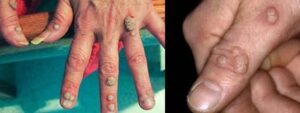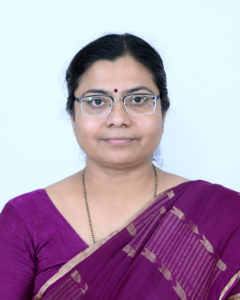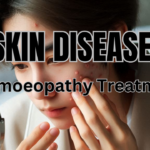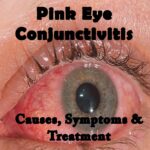Warts are one of the common viral infections, typically small, rough, hard growths on the skin. It is called as Charmakeela in Ayurveda and most forms spread by casual skin contact or through shared objects, such as towels or washcloths.


Warts are typically small, rough, hard growths on the skin, they usually occur on the hands and feet, they can also affect other parts of the body. They typically do not result in other symptoms. There may be one or many warts. Sometimes painful if manifest on bottom of the feet.
It is one of the common viral infections, caused to humans and contagious. Kids get warts most often, teens and adults can get them. Sometimes warts are sexually transmitted and appear in the genital area. But most warts affect the fingers, hands, and feet.
Warts are caused by the human papilloma virus (HPV). There are about 130 known types of human papilloma viruses. HPV infects the squamous epithelium, usually of the skin or genitals, but each HPV type is typically able to infect a few specific areas on the body. Many HPV types can produce a benign growth, often called a “wart” or “papilloma”.
Common warts are transmitted by touch. It can take wart to develop two to six months to develop, they usually harmless and eventually disappear on their own. But many people choose to remove them because they find them as embarrassing. Some strains of HPV are acquired through sexual contact. Most forms spread by casual skin contact or through shared objects, such as towels or washcloths.
The virus usually spreads through breaks in your skin, such as a hangnail or a scrape. Biting your nails also can cause warts to spread on your fingertips and around your nails. Each person’s immune system responds to the HPV virus differently, so not everyone who comes in contact with HPV develops warts.
Symptoms
Common warts usually occur on your fingers or hands and may be:
- Small, fleshy, grainy rounded top
- Flesh-colored, white, pink or tan
- Rough to the touch
- Sprinkled with black pinpoints, which are small, clotted blood vessels.
Types of warts
There are five major types of warts, each types appears on different part of the body has a distinct appearance.
- Common warts- Grows on finger and toes, can appear elsewhere-rough, grainy and rounded top.
- Plantar warts-grow on soles and feet, rougher.
- Flat warts-grow on face, thigh, arms, and small not immediately noticeable.
- Filiform– around mouth or nose or neck and chin, tiny tag on skin with same colour.


When to see a doctor
See your doctor for common warts if:
- The growths are painful or change in appearance or colour
- You’ve tried treating the warts, but they persist, spread or recur
- The growths are bothersome and interfere with activities
- You aren’t sure whether the growths are warts
- You are an adult and numerous warts begin to appear, which may indicate the immune system is malfunctioning.
Risk factors
People at higher risk of developing common warts include:
- Children and young adults, because their bodies may not have built up immunity to the virus
- People with weakened immune systems, such as those with HIV/AIDS or people who’ve had organ transplants
Prevention
To reduce your risk of common warts:
- Avoid direct contact with warts. This includes your own warts.
- Don’t pick at warts. Picking may spread the virus.
- Don’t use the same emery board, pumice stone or nail clipper on your warts as you use on your healthy skin and nails. Use a disposable emery board.
- Don’t bite your fingernails. Warts occur more often in skin that has been broken. Nibbling the skin around your fingernails opens the door for the virus.
- Groom with care. And avoid brushing, clipping or shaving areas that have warts.
Treatment
- If warts persist for long- Salicylic acid, counter cream, gel, medicated band aid with Salicylic acid.
- Pumic stone or emery board to rub dead skin from surface of wart.
- Minor surgery to remove the wart.
- Laser surgery– laser to burn and destroy wart tissue.
- Cryotherapy– All these treatments carried out by health care professionals.
- To boost the immunity and good skin Vitamin A and good nutritious food advised.
In Ayurveda
Warts are called Charmakeela, charma means skin. Keela refers to growth or mass eruption. With balancing vata-kapha dosha. Treatment includes
- The application works well when the wart area becomes moist top layer of dead skin is scraped out. Scraping can be done with palasha patra. Do not do excessive scraping.
- Agni karma can also useful treatment same procedure in modern cauterization. And as well as excision can be done.
- External application- Tankana basma mixed with lemon juice and fine paste is made and applied over the warts.
- Taking yavakshara and saindava lavana (rocksalt) equal quantity, fine power is made mixing with cow’s urineand dehydrated lime powder added and paste is placed.
- Take kshara powder-yava, kalyanakshara, palasha ksara apply it on the wart and cover it with band aid or hansaplast over for a day remove the duct tape.
- Oral medications which are rakta shodhaka – arogyaverdini tab, panchanimbadi gulika, and khadirarista can be used. It is best to undergo these therapies under the care of an ayurvedic physician.


Dr. Rekha – Associate professor
SDM ayurveda hospital & college
Mysuru road, Bengaluru-98
Ph: 080-2324 1888 Mob: 99450 78171











